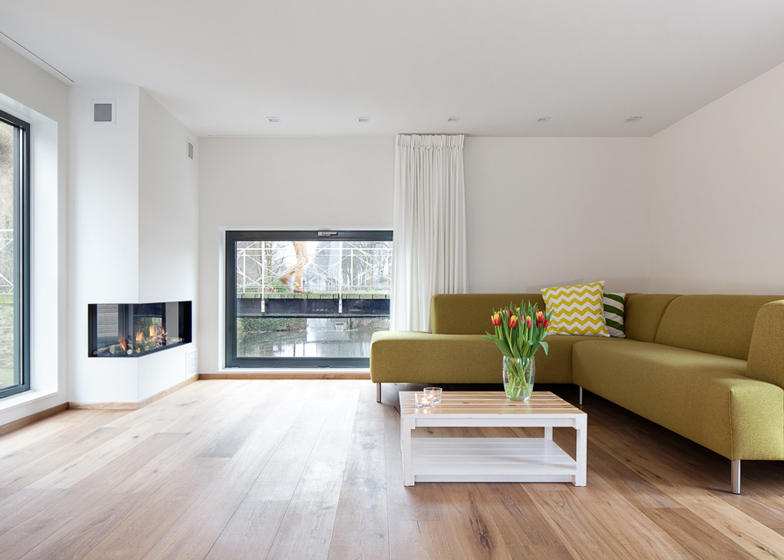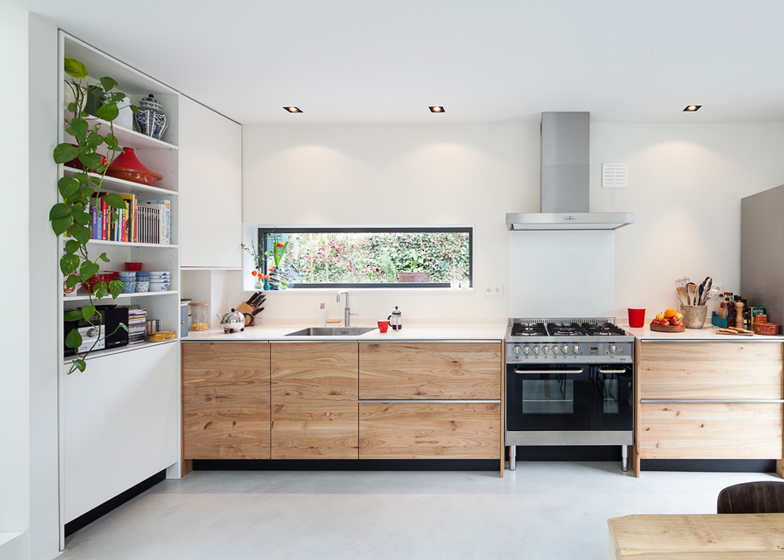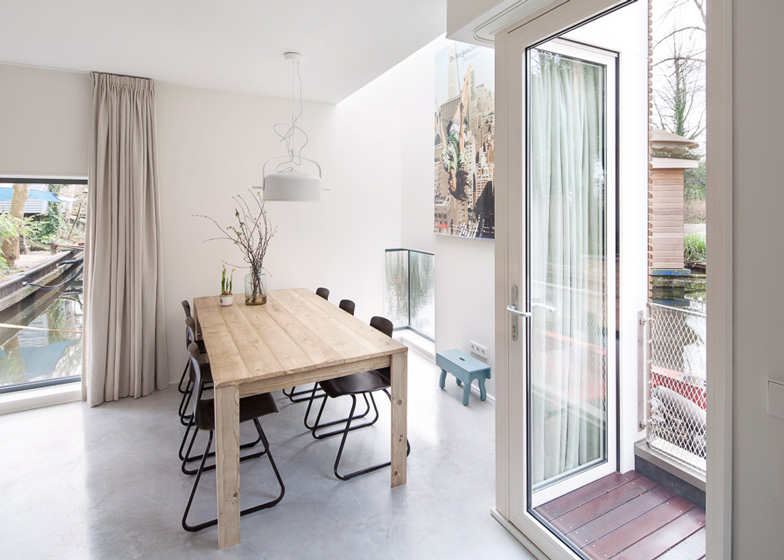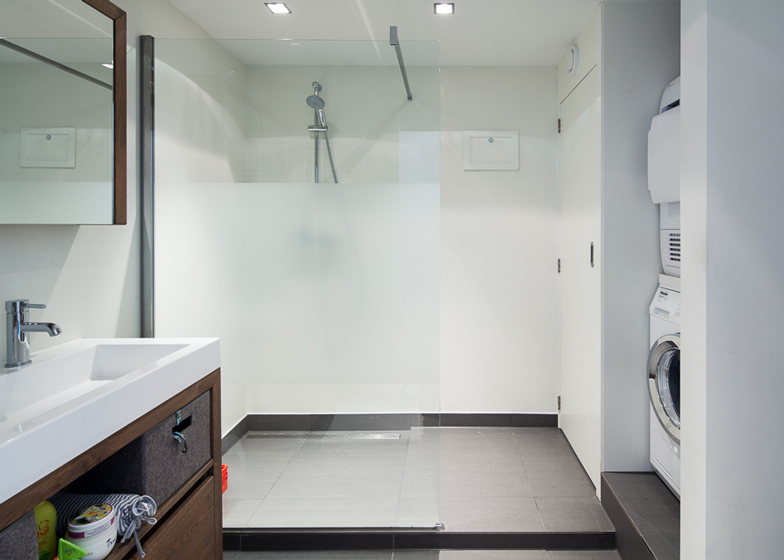Copper panels and local timber clad the exterior of this houseboat in the Netherlands by BYTR Architects, which is moored beside a wooded parkland (+ slideshow).
ParkArk was designed by Rotterdam-based firm BYTR Architects for a young family who wanted to live beside a seventeenth-century park in Utrecht.
Formerly living in a steel ship, the family briefed the architects to create a houseboat that had the intimacy of their last home, with a more modern design.
"They wanted to have the full experience of living and floating on the water, though without the application of a hackneyed nautical form language, such as portholes," Richèl Lubbers of BYTR Architects told Dezeen.
The boat is permanently moored on a canal that runs alongside a wooded parkland and has easy access to a cycle route that the family can use.
Pre-heated timber clads the exterior of the boat and copper sheets sit above the water's edge, designed to gently blend the boat's reflection with the facade.
A large skylight at the centre of the boat looks up into the trees and lets the sunlight in at the centre of a vegetated roof, covered with sedum and grass. A decked terrace also sits level with the green roof, offering views down the canal and out to the surrounding landscape.
"We decided to keep the roof as a private part for the family, with no physical borders or fences towards the park setting, making it feel as much as possible like it's part of the surroundings," Lubbers explained.
Moored to the side of a boat, a red fishing punt bobs on the water for the family to take a trip down the canal when the weather is good.
"The fishing boat, which floats next to the terrace, gives a great feeling of freedom and allows the clients to jump in for a lazy boat trip," Lubbers said.
From the canal side, a front door leads into a hallway with access to the roof terrace and steps down to the water's edge. An open-plan space with white walls is designed to make the interior feel more spacious.
"The external staircase connecting to the roof terrace also continues the white stucco of the interior, creating the atmosphere of an outdoor room," the architects explained.
A living room sits to the right of the hallway, with a home-made boxed shelving unit for the family's possessions and 1970s-style furniture surrounding a corner fire place.
French oak floorboards run throughout the houseboat's living spaces, while a kitchen on the other side of the hallway features red cherish wood cupboards, sourced locally and designed to contrast with the neutral interior.
A dining room connects to the fishing punt deck on a lower level leading down from the kitchen, with a pine table made by the family at the centre of the room. Windows are dotted round the space to allow light in without nearby pedestrians looking inside.
In the bowel of the boat, a ground floor sleeping level comprises a master suite and two single beds, with a shared family bathroom. A crawlspace has also been created to look out across the water.
Other houseboats we've published include a floating residence in Amsterdam constructed from geometric timber batons and a curvy houseboat on the River Amstel.
Here's some more text from BYTR Architects:
ParkArk, Utrecht
The ParkArk of Hieke and Sietze, located next to a busy cycling route through a park, has been completed. The combination of the publically visible moorage and the client's residential needs were central concerns during this design.
The clients had a number of requests. Firstly, they wanted the ark to be larger than their former one, while maintaining the intimate atmosphere of their former steel ship. Also, they wanted to have the full experience of 'living and floating on the water', though without the application of a hackneyed nautical form language, such as portholes. Finally, they wanted a boat where no one can look in, but at the same time they wanted a full view of the park.
As a visitor, one first approaches the boat over a footbridge, to find a door that barely gives away anything of the interior. Inside, however, a large skylight offers you a view of the treetops, and directly in front of you the park is visible. Opposite the front door is an access to the roof terrace and the mooring for the fishing punt. On either sides are the living and dining room, accessible from the open hall, which is raised one step to give extra ceiling height in the shower.
The facade consists of multiple materials, giving a special appearance. The copper sheets at the bottom nearly touches the water, causing a the boat's reflection to gently blend with the facade. The fenestration establishes a balance between privacy and maximised views of the park. The external staircase connecting to the roof terrace continues the white stucco of the interior, creating the atmosphere of an outdoor room.
The port authority of Utrecht allows maximum external dimensions of 5 x 16.5 meters, 1 meter depth, and 4 meter above the water level. The design of a floating houseboat provides additional challenges with respect to structures with foundations. Besides the strict external dimensions there must be a balance in the distribution weight. A heavy bookcase can indeed cause the boat to tilt, and subsequently, this may cause rainwater to accumulate on the roof, furthering the tilt. While not visible from the outside, the houseboats has drainpipes at every corner making this scenario impossible. The use of 3D models made it possible to develop key details before the execution. A method that is not feasible in every private project.
Almost every design decision hinged on experiential values, and not just those of the resident. The clients also thought about the experience of visitors, like the reflection of the facade in the water.
Many houseboat owners have a big "do it yourself" mentality, because that is more or less required for living on the water. Sadly, this does not always produces aesthetically pleasing houseboats. That doesn’t always turns out to beautiful houseboats. This project, though, shows that a carefully balanced design provides added visual aesthetic value in this public place.



















